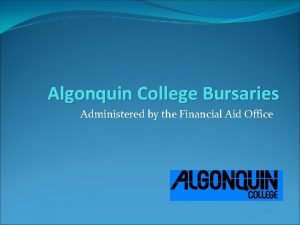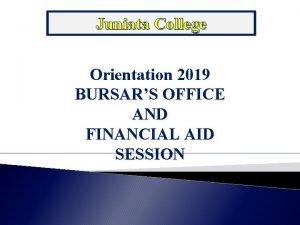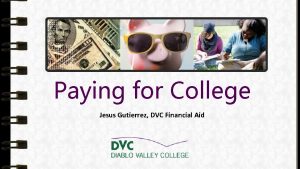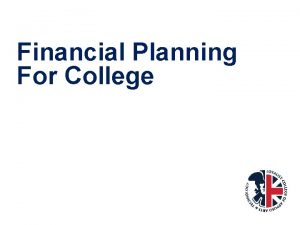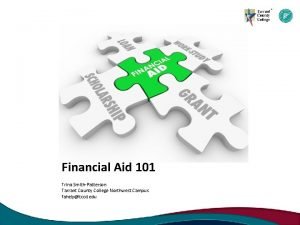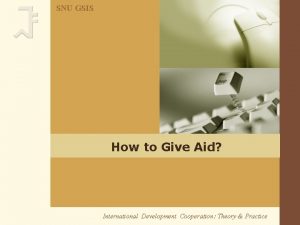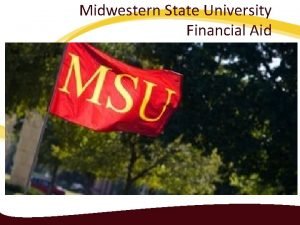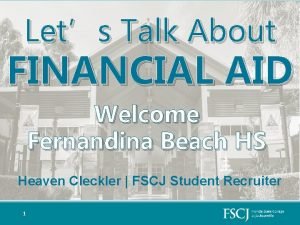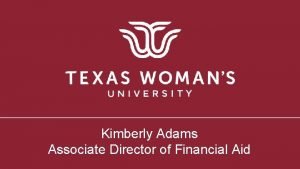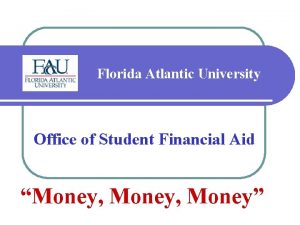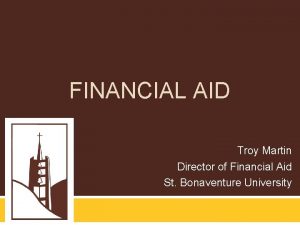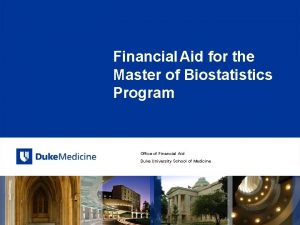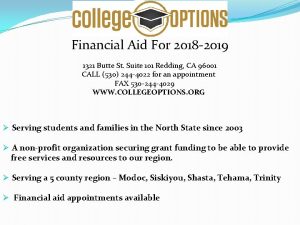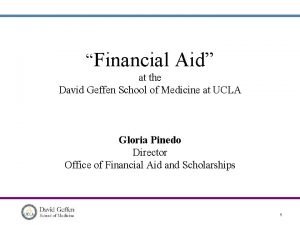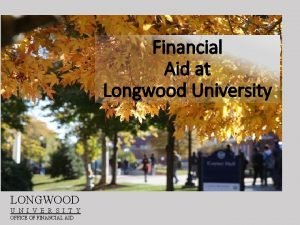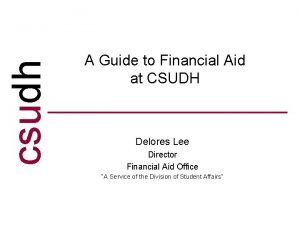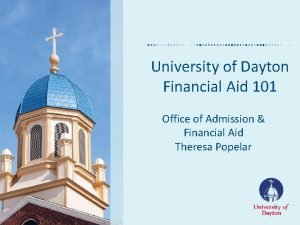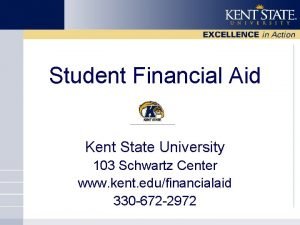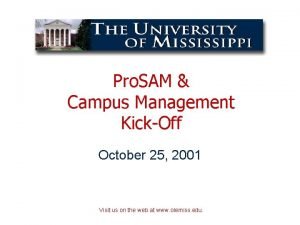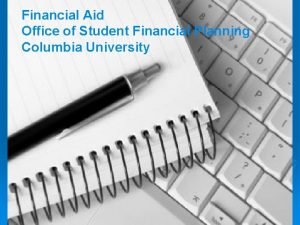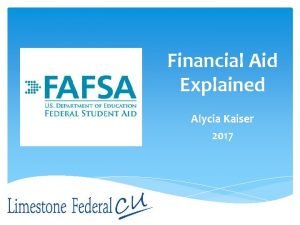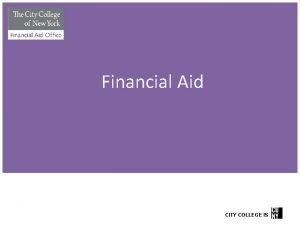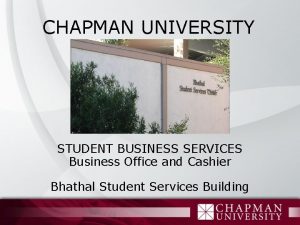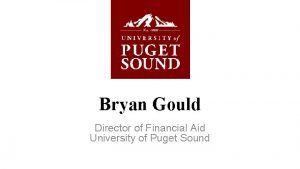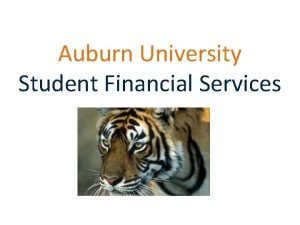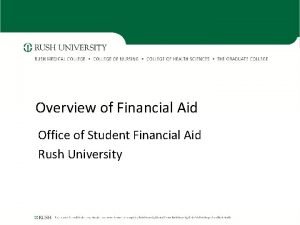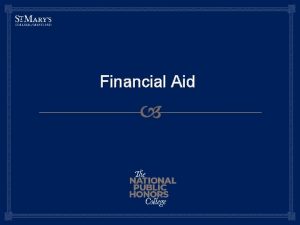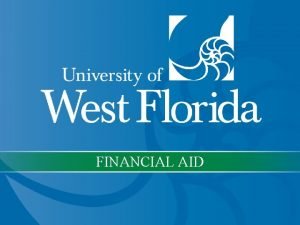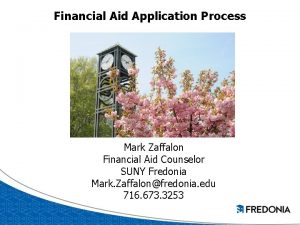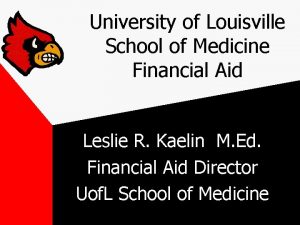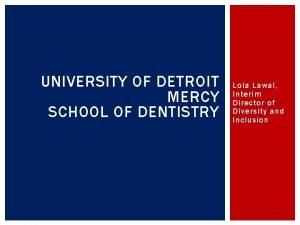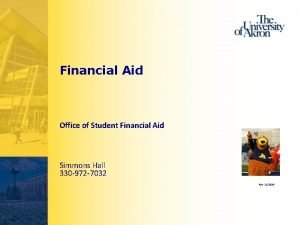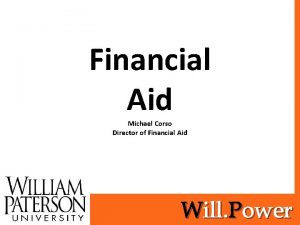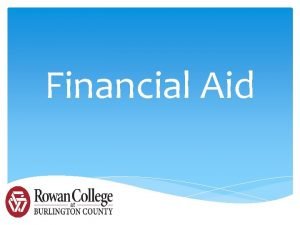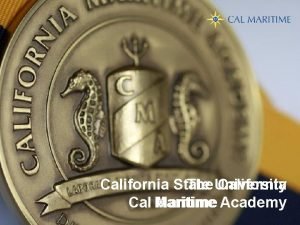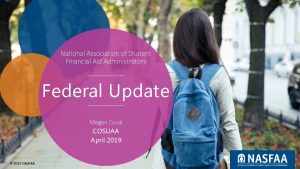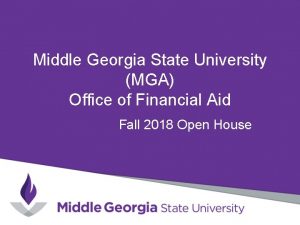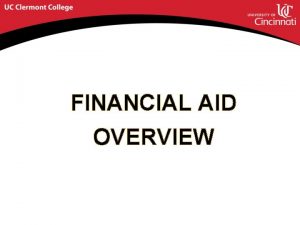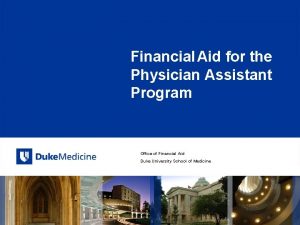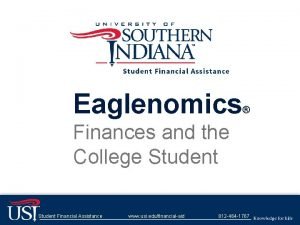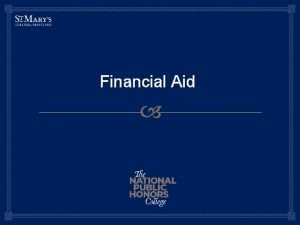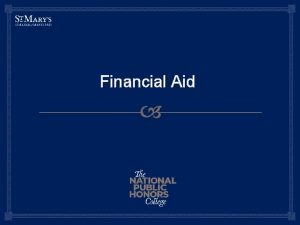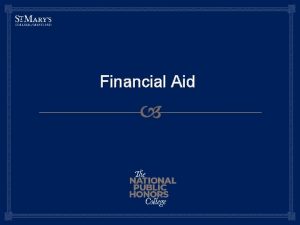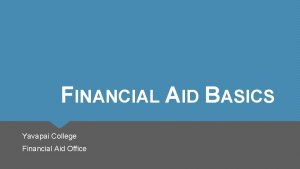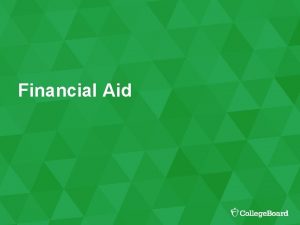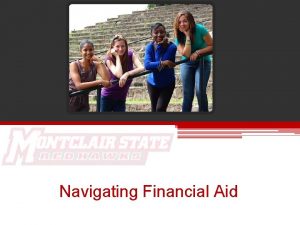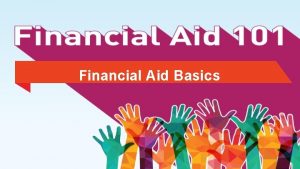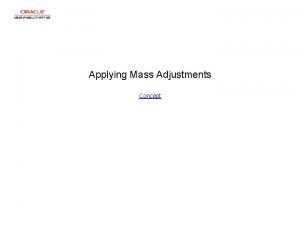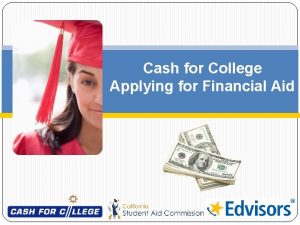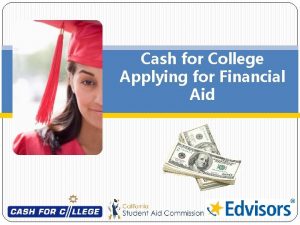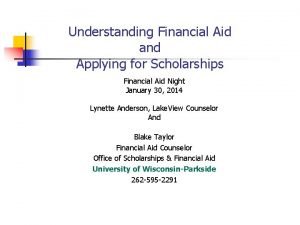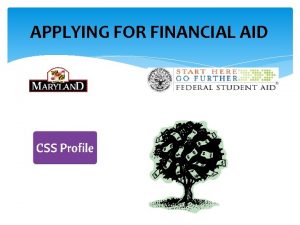FINANCIAL AID College of COHP APPLYING FOR FINANCIAL





















































- Slides: 53

FINANCIAL AID College of COHP

APPLYING FOR FINANCIAL AID FAFSA Application: § www. fafsa. gov (UTHSC School code: 006725) FAFSA Opens - (October 1 st) § Completed for each school year

STEPS TO COMPLETE FAFSA VERIFICATION CORRECTIONS MASTER PROMISSORY NOTE ENTRANCE COUNSELING ACCEPT AWARD TUITION/FEES PAID REFUND DISBURSED

STEPS TO COMPLETE VERIFICATION- additional documents are required –verification worksheet, tax transcript AWARD NOTICE SENT- student will receive an email notice sent to the UTHSC email account

Master Promissory Note (MPN) Includes your rights and responsibilities as a borrower and it’s the legal document all student loan borrowers must complete promising to repay the loan.

ENTRANCE COUNSELING Loan information session explaining rights & responsibilities Sign in to Student. Loans. gov using your Federal Student Aid PIN § Select "Entrance Counseling"

ACCEPT AWARD To view your awards, follow these 5 steps: Login to Banner Self-Service Click on Financial Aid Next, click on Award for Aid year and select year Accept the Terms and Conditions Lastly, you should click on Accept Award Offer * NOTE: When accepting awards, you are accepting for the entire year and not just for the term.

TUITION/FEES PAID Financial aid must first pay a student's tuition and fees each term. If excess funds remain after paying these expenses, the student is sent a financial aid refund to help them pay for their books and living expenses.

REFUND DISBURSEMENT All refunds are direct deposited to your checking account or mail. The student should make sure that they are signed up for direct deposit as that ensure the quickest way for the student to receive a financial aid refund.

BANNER SELF-SERVICE Direct Deposit Setup 1. Go to: Banner Self-Service 2. Enter Your Net ID and Password. 3. At the Main Menu, click on Student. 4. On the Student menu, click on Student Account. 5. Click on Account Summary. 6. Next, click on Pay Your Fees. 7. Click on e. Refunds and follow instructions to set up account.

FINANCIAL AID AWARDS Loans Scholarships Grants College Work-Study Cost of Attendance Budgets Forms

Loan Limits

TYPES OF LOANS Direct Unsubsidized Loan Direct Graduate Plus Loan Private/Alternative Loan

LOAN AMOUNTS UNSUBSIDIZED STAFFORD $20, 500 GRADUATE PLUS Cost of Attendance Minus Other Aid

Cost of Attendance

2018 -19 OUT-OF-STATE COST OF ATTENDANCE ESTIMATE Tuition Room &Board Books and Supplies Transportation Miscellaneous Total $29, 534 $11, 580 $1, 000 $2, 520 $7, 434 $52, 068

OUT-OF-STATE PACKAGING EXAMPLE COA = $52, 068 $20, 500 Direct Unsubsidized Loan $27, 568 Graduate Plus $ 4, 000 College Work-Study $52, 068

2018 -19 IN-STATE COST OF ATTENDANCE ESTIMATE Tuition/Fees $10, 884 Room & Board $11, 580 Books and Supplies $1, 000 Transportation $2, 520 Miscellaneous $7, 434 Total $33, 418

IN-STATE PACKAGING EXAMPLE COA = $33, 418 Direct Unsubsidized Graduate Plus College Work-Study Total $ 20, 500 $ 8, 918 $4, 000 $33, 418

Additional Funds Request

ONE ON ONE COUNSELING ALL incoming students are required to schedule and complete a one-on-one counseling session with their Financial Aid Counselor. Students must complete counseling – April 2019 Student will not be able to register for Fall 2019 term. Office Visit Phone MANDATORY!!!

CONTACT INFORMATION Gloria Dobbs Financial Aid Counselor College Of Health Professions (901) 448 -1472 gdobbs 1@uthsc. edu


Budgeting

CREATE A BUDGET Budgeting is the process of creating a plan to spend your money. This spending plan is called a budget. Creating this spending plan allows you to determine in advance whether you will have enough money to do the things you need to do or would like to do. http: //uthsc. edu/financial-aid/flight/budgeting. php

PERSONAL BUDGETING – GET STARTED! v Establishing a budget and sticking to it v Distinguish between necessities and wants v Pay bills on time so that you can avoid late fees v Control or limit the use of credit cards v By working on your budgeting skills now, you will know exactly what you can afford in the future.

BUDGETING APPS The app automatically updates and categorizes transactions, creating a picture of spending in real time. It crunches the numbers to show much money is available after accounting for bills, spending and savings goal contributions. All users can view how much money is left “in their pocket” for the day, week or month. • Pocket. Guard gives users a snapshot of how much they can spend at any given moment • Free • i. OS, Android Get started

WHY IS BUDGETING SO IMPORTANT? Budgeting is simply balancing your expenses with your income. If they don't balance and you spend more than you make, you will have a problem. Many people don't realize that they spend more than they earn and slowly sink deeper into debt every year. Following a budget or spending plan will also keep you out of debt or help you work your way out of debt if you are currently in debt.


CREDIT SCORE RANGE SCALE • FICO Score range: 300 -850. • Vantage. Score 3. 0 range: 300– 850. • Experian's PLUS Score: 330 -830. • Trans. Union New Account Score 2. 0: 300 -850. • Equifax Credit Score: 280– 850.

WHAT IS A FICO SCORE? You have a FICO Credit Score from each of the three major credit bureaus: Equifax, Experian, and Transunion. Each of these credit scores is based on different information that each of the credit bureaus has for you. And this available information may very well differ from bureau to bureau. Because the FICO credit score can only be determined by information found in the individual’s credit file, it is essential to look over your credit reports each year to find any inaccuracies or discrepancies to ensure that everything is accurate and up to date. The Fair Isaac Corporation is who has come up with FICO credit scores and subsequently, these scores are used by over 90% of lenders when it comes to providing you with a loan. They are also used when they grant the interest rates, monthly payments, and terms of each loan, and whether you are approved or not.

WHAT IS A GOOD CREDIT SCORE? Most credit scores – including the FICO score and Vantage Score 3. 0 – operate within the range of 300 to 850, and a good credit score is typically one that is 700 or above. • • • Excellent Credit: 750+ Good Credit: 700 -749 Fair Credit: 650 -699 Poor Credit: 600 -649 Bad Credit: below 600

FICO Credit Scores – It Matters

CREDIT BUREAUS o Equifax www. equifax. com 1 -800 -525 -6285 o Experian www. experian. com 1 -888 -397 -3742 o Transunion www. transunion. com 1 -800 -680 -7289 o **Free credit report authorized by the Federal Trade Commission: www. annualcreditreport. com www. Credit. Karma. com


WHAT DO THIEVES DO WITH YOUR INFORMATION? Once identity thieves have your personal information, they can drain your bank account, run up charges on your credit cards, and open new accounts. An identity thief can file a tax refund in your name and get your refund. Make sure all personal information is stored in a safe place. And all passwords can only be determined by you. For more information: Federal Trade Commission – Consumer Information (www. consumer. ftc. gov )

Student Loan History

NSLDS – LOAN HISTORY The National Student Loan Data System (NSLDS) is the U. S. Department of Education's (ED's) central database for student aid. NSLDS receives data from schools, guaranty agencies, the Direct Loan program, and other Department of ED programs. NSLDS Student Access provides a centralized, integrated view of Title IV loans and grants so that recipients of Title IV Aid can access and inquire about their Title IV loans and/or grant data.

2018 -19 INTEREST RATE Direct Unsubsidized Loans Graduate or Professional 6. 6% Direct PLUS Loans Graduate or Professional 7. 6% Students All interest rates shown in the chart above are fixed rates that will not change for the life of the loan.

ORIGINATION FEE Origination fee - An amount, usually calculated as a percentage of a loan, which a lender charges for processing your application.

CREDIT CHECK WITH GRADUATE PLUS LOAN Requires a credit check as part of the application process You cannot have any adverse credit history Obtain an endorser Your credit is evaluated every time you request a new PLUS loan - after 120 days

NSLDS. ED. GOV View your federal student aid history Get your loan servicer’s contact information Download your federal student aid history into a text file using the My. Data Download function Establish an online account with Loan Servicing to track your loan history while school…

L t n e Stud y a p e R n a o s n a l P t n e m

ACCRUED INTEREST Accrued interest is the amount of loan interest that is accruing while you are in-school, but has not yet been paid to the lender by the borrower. Capitalization - adding unpaid, accumulated interest to the principal balance of your loan. Capitalization increases the total cost of your loan.

UNDERSTANDING REPAYMENT PLANS Student borrowers may repay their student loans through one of the several repayment plans: Standard Repayment Graduate Repayment Income Base Repayment (IBR) Pay As You Earn (PAYEE)

STANDARD REPAYMENT PLAN Under this plan, the borrower will pay a fixed amount of at least $50 each month for up to 10 years. For most borrowers, this plan results in the lowest total interest paid because the repayment period is shorter than it would be under any of the other repayment plans. (Subsidized, Unsubsidized and PLUS Loans) Standard Repayment Graduate Repayment Income Base Repayment (IBR) Pay As You Earn (PAYEE)

GRADUATED REPAYMENT PLAN The Graduated Repayment Plan may be beneficial if the borrower’s income is low when they leave school but is likely to steadily increase. Under this plan, payments start out low and then increases every two years. Like the Standard Plan, the maximum repayment period is 10 years for Subsidized, Unsubsidized, and PLUS Loans. Standard Repayment Graduate Repayment Income Base Repayment (IBR) Pay As You Earn (PAYEE)

INCOME-BASED REPAYMENT Standard Repayment Graduate Repayment Under IBR, monthly payment is based on the borrower’s Income-Base Adjusted Gross Income (AGI), Repayment (IBR) family size, and state of residence. Monthly payments are adjusted each year according to changes in your income and family size – new application must be submitted. Pay As You Earn (PAYEE) lator u c l a c , t e act she f R B I le on n b A a l i a v a is and Q&A nt. Aid. ed. gov de www. Stu

PAYE – PAY AS YOU EARN New borrower - no outstanding balance on a Direct Loan or FFEL Program of federal loans. All undergraduate loans must be paid in full and cannot be consolidated Standard Repayment Graduate Repayment Income Base Repayment (IBR) Pay As You Earn (PAYEE)

POSTPONE PAYMENT You can receive a forbearance that allows you to temporarily postpone or reduce your federal student loan payments. Postponing or reducing your payments may help you avoid default. With forbearance, you may be able to stop making payments or reduce your monthly payment for up to 12 months. Interest will continue to accrue on your subsidized and unsubsidized loans (including all PLUS loans).

RESOURCES: Financial Literacy Newsletter: FLIGHT News Financial Literacy Website http: //www. uthsc. edu/finaid/flight/index. php Facebook Page: UTHSC Flight Financial Literacy Library: (located in the One-Stop)

Questions & Answers

CONTACT INFORMATION Ms. Janice G. Maddox, MBA Coordinator, Financial Literacy Counselor, College of Dentistry One Stop Shop (901) 448 -1601 jmaddox 9@uthsc. edu Skype: Janice. maddox 3
 Algonquin college foundation
Algonquin college foundation Juniata college financial aid
Juniata college financial aid Fafsa dvc
Fafsa dvc Loyalist college financial aid
Loyalist college financial aid Tccd financial aid office
Tccd financial aid office Sacramento city college graduation requirements
Sacramento city college graduation requirements Linfield financial aid office
Linfield financial aid office First aid merit badge first aid kit
First aid merit badge first aid kit Greenhill park medical centre
Greenhill park medical centre Financial aid card
Financial aid card Www southeastern edu financialaid
Www southeastern edu financialaid Snu financial aid
Snu financial aid Midwestern state university financial aid office
Midwestern state university financial aid office Fscj financial aid office
Fscj financial aid office Twu fin aid
Twu fin aid Financial aid office fau
Financial aid office fau Troy financial aid office
Troy financial aid office Duke financial aid office
Duke financial aid office Butte financial aid
Butte financial aid Dgsom financial aid
Dgsom financial aid Longwood university financial aid
Longwood university financial aid Financial aid office csudh
Financial aid office csudh Baylor tuition calculator
Baylor tuition calculator Dayton financial aid
Dayton financial aid Michael schwartz center kent state
Michael schwartz center kent state Prosam financial aid
Prosam financial aid Msu texas financial aid
Msu texas financial aid Financial planning columbia
Financial planning columbia Kaiser financial aid
Kaiser financial aid Ccny financial aid office
Ccny financial aid office Chapman business office
Chapman business office University of puget sound financial aid
University of puget sound financial aid Auburn university student financial services
Auburn university student financial services Iup bursar
Iup bursar Dmacc online bookstore
Dmacc online bookstore Rush financial aid
Rush financial aid Fvsu homepage
Fvsu homepage Financial aid
Financial aid Vanderbilt university isfaa
Vanderbilt university isfaa Uwf financial aid office
Uwf financial aid office Suny fredonia financial aid
Suny fredonia financial aid Nuig financial aid
Nuig financial aid Uofl bursars office
Uofl bursars office Udm dental admissions
Udm dental admissions Uakron financial aid office
Uakron financial aid office William paterson financial aid office
William paterson financial aid office Rcbc financial aid
Rcbc financial aid Cal maritime uniforms
Cal maritime uniforms Financial aid csuci
Financial aid csuci National association of financial aid administrators
National association of financial aid administrators Mga financial aid
Mga financial aid Uc clermont financial aid
Uc clermont financial aid Duke pa program tuition
Duke pa program tuition Usi financial aid office
Usi financial aid office
